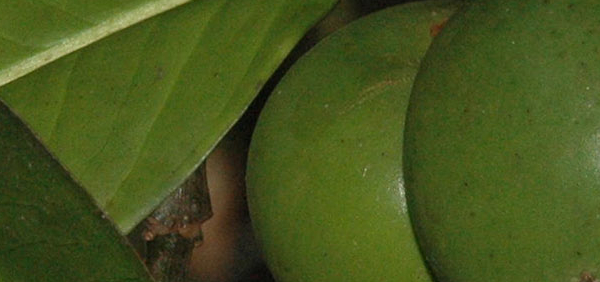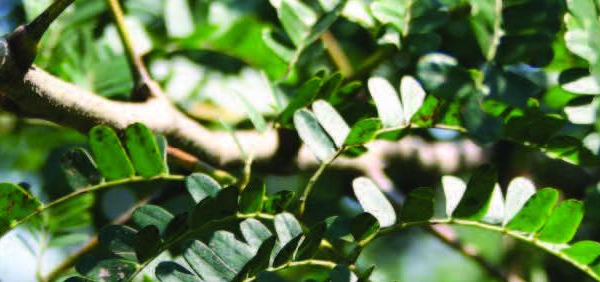tikshnaksha :
 Toddalia asiatica (L) Lam. (Rutaceae) (Syn: Paullinia asiatica L., Scopolia aculeata Sm., Toddalia aculeata Pers.) is amedicinal plant commonly known as Orange climber (Eng.).The species is traditionally used as a browse for goats and as ahedge among the Maasai and Kipsigis communities (Glover etal., 1966a). However, the most important use of Toddalia asiatica is medicinal.
Toddalia asiatica (L) Lam. (Rutaceae) (Syn: Paullinia asiatica L., Scopolia aculeata Sm., Toddalia aculeata Pers.) is amedicinal plant commonly known as Orange climber (Eng.).The species is traditionally used as a browse for goats and as ahedge among the Maasai and Kipsigis communities (Glover etal., 1966a). However, the most important use of Toddalia asiatica is medicinal.HISTORICAL AND MYTHOLOGICAL REVIEW:
Taxonomical Classification
Kingdom: Plantae - Plants
Subkingdom: Streptophyta
Superdivision: Spermatophyta - Seed plants
Division: Magnoliophyta - Flowering plants
Class: Magnoliopsida - Dicotyledons
Family: Rutaceae
Genus: Toddalia
Species: Toddalia asiatica
Allied species:
Aralia labordei H.Lév.
Paullinia asiatica L.
Toddalia aculeata Pers.
Toddalia angustifolia Lam.
Toddalia floribunda Wall.
Toddalia nitida Lam.
Toddalia rubricaulis Roem. & Schult.
Toddalia tonkinensis Guillaumin
VERNACULAR NAMES
Sanskrit: Kanchanah, Tiksnaksah, DahanaEnglish: forest pepper, wild orange tree, Lopez-root tree
Hindi: Jangli Kali Mirch, Kanch, Dahan
Telugu: Konda Kasinda, Vana Kasinda, Mulla Kasinda, Erra Kasinda, Mirapakanda, Mulla Morinda
Bengali: kada-todali
Marathi: दहन dahan, जंगली काळी मिरची jungli kali mirchi, रान मिरवेल ran mirvel
Konkani: Galayi
Oriya: ହାଇମରିଚା hai maricha, ତୁଣ୍ଡ ପୋଡ଼ା tunda porda
Tamil: Milagaranai, Kattumilagu
Malayalam: കാക്കത്തുടലി kakkattutali ,Mulakutali, Vallinarakam, Kara, Mulakutanni
Kannada: Kaadumenasu, Inasingi.
Japanese: Saru-kake-mikan
Chinese: XIiao jin teng, You po le, Hua mei tiao, San xue fei, Wen dan, Yi lei, Jian xue fei, Huang jiao gen, Xi jiao, Huang jiao gen, Ci mu teng, Huang rou shu, Da jiu jia, Niu ma le, Ji zhao le, Ru shin hu, Fei long zhang xue
French: liane patte poule piquante
Nepal: मैन-काँड़ा main kanda
Sinhalese: Kudumirissa
Varities:
Two varieties of Toddalia asiatica viz var. gracilis and var. floribunda are found in the west and southern parts of India. Plants of var. gracilis are generally found in denuded slopes.Definition
Synonyms
Synonyms in Ayurveda: tikshnaksha, kancana, dahanaRasa: Kashaya Madhura Tikta
Guna: Laghu Snigdha
Veerya: Ushna
Vipaka: Katu
Karma: Kaphahara Vatahara
The fruit is traditionally used to treat malaria and coughs; roots to treat indigestion and influenza and theleaves for lung diseases and rheumatism. Toddalia asiatica is also used to treat nasal and bronchial pains, stomachache, snake bites, andin rituals
Cultivation:
A plant of subtropical to tropical climates, it will only flourish in frost-free areas with a fairly high annual rainfall.Succeeds on clay soils.
The whole plant is covered in numerous glandular dots which contain acidic oils - it is believed that these can help protect the plant from pests.
A dioecious species, both male and female forms need to be grown if fruit and seed are required.
Propogation:
Seed - it germinates quickly.Cuttings about 30cm long taken from the growing tips. Place the cuttings in damp sand. A growth hormone can be used to stimulate the development of roots
Harvesting:
The plant is harvested from the wildPhytochemistry:
The root bark of T. asiatica is a rich source of active constituents belonging to various classes of secondary metabolites which include benzophenanthridine, quinoline, protoberberine alkaloids, coumarins, biscoumarins, furanocoumarins, benzopyrans, terpenoids, cyclohexylamides. Literature reveals that several of these chemical constituents have been isolated and studied for their pharmacological activitiesPHARMACOLOGY:
Important formulationsParts used for medicinal purpose
Bark, Fruit, Leaves, Root, ,Dosage:
6 to 9 gms dried material in decoction.Controversy:
Fossil seeds of Toddalia have been described as †Toddalia nanlinensis from the Miocene of Nanlin Formation in Longchuan Basin, Dehong Autonomous Prefecture, Yunnan Province, China; the fossil seeds are boat-shaped with tegmen that is composed of thin-walled cells with fine criss-crossed spiral lignificationsCommercial value:
Morphology:
It is an evergreen climber (woody Liana) with rambling stems up to 15 m high and 10 cm diameter. Bark of the plant is pale brown, fairly smooth with numerous conspicuous pale circular lenticels, armed with small hooked prickles about 2.5 mm long raised on old stems on the top of a conical woody pedestal up to 1.2 cm high. Blaze 2.5-7.5 mm crisp, pale yellow closely mottled with sclerotic orange portions in the outer half, turning pinkish brown on exposure. Leaves are alternate, digitately trifoliate. Petiole 1.5-3 cm long. Leaflets sessile, 5-10 cm x 1.8-3.8 cm, obovate- oblong or oblong, crenulate, shortly blunt-acuminate, base acute, glabrous, criaceous, dark shining green above with many slender parallel nerves. Inflorescences with male flowers corymbose panicles, with female flowers cymose panicles, bract scale like. Flowers polygamous, 3.8-6 mm diameter, pale greenish yellow, in axillary and terminal pubescent panicles, 2.5-6.3 cm long. Stamens 4 or 5, ovary 4 or 5 locular. Fruit orange to dark red, 7.5-12mm. diameter, subglobose, with 5 shallow grooves, yellowish, seeds dark brown, several reniform, surrounded by colorless mucilageHistology:
T.S of leaf consists of single layers of upper and lower epidermis covered with thin cuticle. Mesophyll is differentiated in to upper palisade and lower spongy cells. Palisade consists of compactly arranged cylindrical cells and filled with chloroplast. Oil glands are observed on both surfaces . Midrib shows well developed vascular bundle. Unicellular and thick walled trichomes were present on midrib. Anisocytic stomata were present on dorsal surface of the leaf , Stomata index was 29.Geographical distribution:
ECOLOGICAL ASPECT:
Forests near rivers or streams. Thickets and forests near coasts, especially in calcareous regions, in southern Japan. Humid forests, from sea-level up to 2300 metresPlant conservation:
Not evaluatedGeneral Use:
The whole plant is aromatic or hot and pungent, and used as a bitter or aromatic tonic. It is used to boost digestive function and to treat feversThe fruit is used as a cough remedy
The roots are used in the treatment of indigestion and influenza
The root and its bark have been used as a remedy for fever, malaria, cholera, diarrhoea and rheumatism.
The leaves are used in the treatment of lung diseases and rheumatism. An infusion is used as a treatment for asthma
Therapeutic Uses:
Root bark considered antimalarial, antiperiodic, antipyretic, tonic and carminative.- Volatile oil from the leaves have a pleasant odor resembling verbena of basilicum.
Systemic Use:
The plant is used medicinally by many African peoples, including the Maasai, who use it for malaria, cough, and influenza. The roots contain coumarins that have antiplasmodial activity. Extracts of the plant have demonstrated antiviral activity against H1N1 influenza in the laboratoryAdministration:
Root extractPharmacological:
Studies have shown antiplasmodial, antimicrobial, antiviral, analgesic, anti-inflammatory, cytotoxic, repellent, antioxidant, anti-diarrheal, antihyperglycemic properties.Clinical trials:
Research:
Use in other system of medicine:
The plant is well known for its antipyretic property. All parts of the plant have characteristic pungent taste. It is used in sprains, contusions, intercostal neuralgia, cough, malaria, dysentery, gastralgia, poisonous snake bites and furuncle infections. Fresh bark of the root is used in the treatment of hill fever. The root is used as dental analgesic. It is also used in odontalgia, paralysis, intermittent fevers, dyspepsia, colic, flatulence, bronchitis, nausea, wounds, filthy ulcers, epilepsy, gonorrhoea, constitutional debility, convalescence after febrile and exhausting diseases, blood motions and arthritis. The root bark is bitter, astringent, acrid, digestive, carminative, constipating, diaphoretic, expectorant, antibacterial, vulnerary, aromatic, tonic, stimulant, antiperiodic, antidiarrhoeal, antipyretic and diuretic. Fresh leaves are eaten raw for pin in the bowel. The leaves are burnt and the ash is used as tooth powder and in decayed teeth. The flowers are useful as an external application in wasp-stings. The unripe fruit is rubbed down with oil to make a stimulant liniment for arthritis. The fruits are used for Cough and throat pain. The roots and leaves are boiled and used orally or inhalation for common cold and cough. Apart from these the fruits are also used for culinary purposes in the form of picklesCONCLUSION:
Toddalia asiatica (Lopez root): Rutaceae, a woody liana, is used traditionally in the treatment of malaria, sprains, cough, fever, neuralgia, epilepsy, dyspepsia and other disease conditions. Extracts of the plant have been reported to have anticancer, anti-HIV, antimicrobial, antifeedant activities. A wide range of chemical constituents such as benzophenanthridine alkaloids, coumarins, cyclohexylamides and terpenoids have been isolated especially from the root bark of the plant.Photos of tikshnaksha - ,
Herbal plants of Srilanka - toddalia asiatica
- Courtesy: http://tropical.theferns.info/plantimages/4/c/4c712dbd6b233fa4903d21e39d59754f757aaad6.jpg
- Courtesy: http://tropical.theferns.info/plantimages/6/7/67679e76acafae90bd196ad0e984d66f53d2b177.jpg
- Courtesy: http://tropical.theferns.info/plantimages/d/4/d4df8e2b4a323fa6b5ef65288032e8a6995c8417.jpg
- Courtesy: https://08511630493324166816.googlegroups.com/attach/d2b33ab2e495048f/DSC_0428c.jpg?part=0.3&view=1&vt=ANaJVrHFJ8G4Q8tS4HeJ0RgYaQxNO5M8LWSF_PitVomgbPvF6gVW__bhMvaodPi45t2ct39fr4wKeGs5r45HhbmfSuTXlQLJhJVZ8zx3P0dqkyn9BYX2FIk
- Courtesy: https://08511630493324166816.googlegroups.com/attach/d2b33ab2e495048f/DSC_0427a.jpg?part=0.1&view=1&vt=ANaJVrHVO6ObxCSHznUAqW5e3BN2rh0rnY0Ste77f1vJb4OHdfPWWg9zxIpJq7zfVsS5AqByoGKpKKWGjL5jDfOGV4bZfD-NbINFhgfWt5QQawbxoVyzwpg
- Courtesy: https://08511630493324166816.googlegroups.com/attach/7d9c4114f97b2ba3/DSCN3530s.jpg?part=0.2&view=1&vt=ANaJVrHEP5fiEPn2YfHYq3m9Zhxwjk_uGsZHnyFRdALHadRedxFxJ_v6tqBHhCFRcoDY6uv6Zwc6A26fz7M6AmEV9NvohZTX9pyirlP4DqbX5mIYV5DnKUM
- Courtesy: https://08511630493324166816.googlegroups.com/attach/fd1ea76e13b964f1/DSC_6778f5_Buds.jpg?part=0.6&view=1&vt=ANaJVrG8IhNOsWh3o5hKSR89HeYVnyOmh4h6Ut0aAb-EWowvjon_AoUL_JJbGukB71UEhBZEV6Vq1TIapid1BUos7FXqndrKWQas86rWeqGQfSKRmCoYdJ0
- Courtesy: https://08511630493324166816.googlegroups.com/attach/522089c3b89fee0/toddalia%20asiatica%20var.%20floribunda_4.JPG?part=0.4&view=1&vt=ANaJVrGooqhqy2hkcOIn9s-LzTN4LWkHVRWxH3-HL_93g-HsCUzIFr9uCRQ6-VdyuTcyv9iyWfVt2_QtHZZcf_vPJWLTelK5uA83AEbGIqaePMc_fIk3LmY
- Courtesy: https://08511630493324166816.googlegroups.com/attach/522089c3b89fee0/toddalia%20asiatica%20var.%20floribunda_2.JPG?part=0.2&view=1&vt=ANaJVrFTkAjOTv4BH4aYsMqPwCcf1lJ-HW9ENOUcCtPUHTM-mB-wgEp5sJak8-TS8bs15IZFvWvQBMGuACeYO0xNbAlEI2-am5_cErPYeLRLTaH7yImlen4
- Courtesy: http://plantillustrations.org/illustration.php?id_illustration=45179&SID=0&mobile=0&code_category_taxon=9&size=1
- Courtesy: http://plantillustrations.org/illustration.php?id_illustration=127561&SID=0&mobile=0&code_category_taxon=9&size=1
KEY WORDS: tikshnaksha Toddalia asiatica (Linn.) Lam., Toddalia aculeata Pers.
- » Classification and names of tikshnaksha
- » Synonyms and definitions of tikshnaksha
- » Drug Properties of tikshnaksha
- » Chemical Constituents of tikshnaksha
- » Standardization of tikshnaksha
- » Parts used and Dosage of tikshnaksha
- » Morphology and Histology of tikshnaksha
- » Distribution and Conservation of tikshnaksha
- » Cultivation of tikshnaksha
- » tikshnaksha in the market
- » Medicinal Uses of tikshnaksha
- » Researches and clinical trails of tikshnaksha
- » tikshnaksha in other sytems of medicine
- » Ayurvedic formulations with tikshnaksha
- » Images of tikshnaksha

Kotakkal Ayurveda - Mother land of modern ayurveda























